Fuchsia spp.
Fuchsia is a genus of eye-catching, vibrant plants that bloom all summer long with glorious teardrop-shaped flowers in a variety of vivid colors.
When you picture fuchsia, you may imagine a hanging basket on a covered porch festooned with pink and purple blossoms cascading over the edge.
Or perhaps you picture a shrub growing in a shady corner of the garden with dainty white flowers?
It can be hard to get vibrant color into those spots that don’t see much sunshine, but fuchsia will happily bloom in the shade.
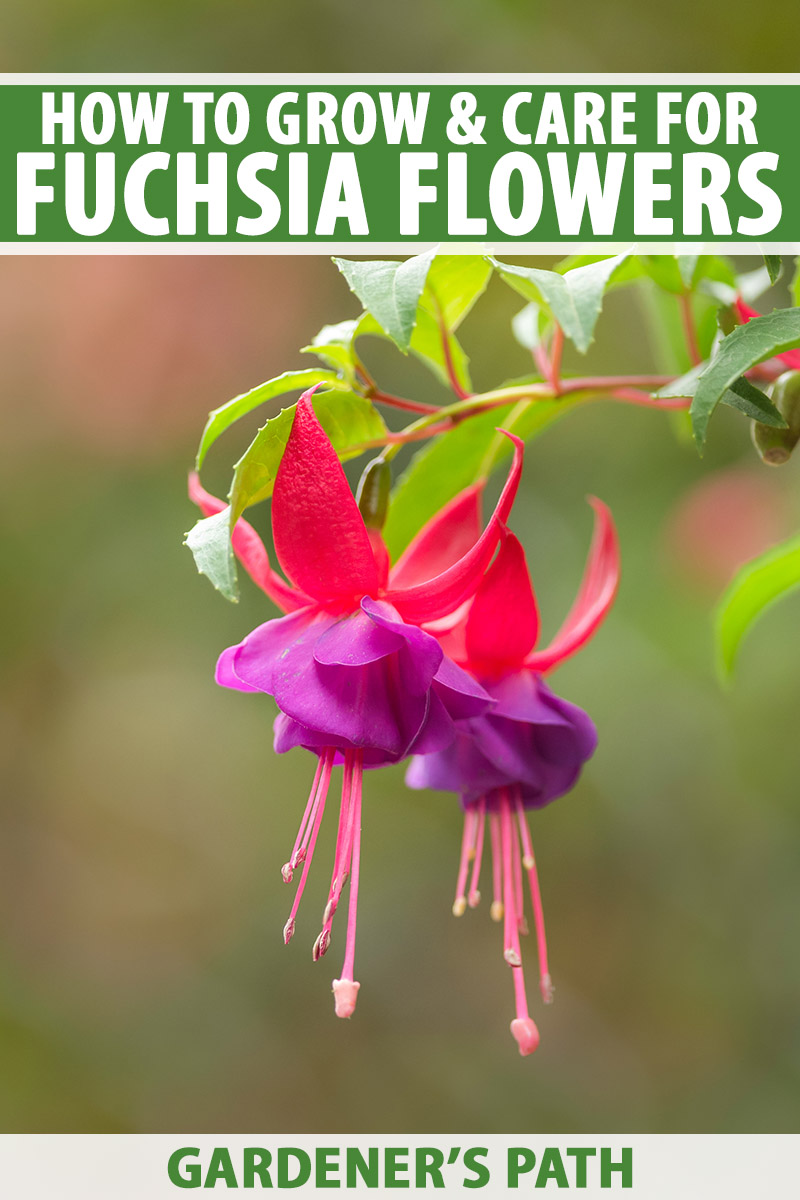
We link to vendors to help you find relevant products. If you buy from one of our links, we may earn a commission.
The familiar pink and purplish-red pendulous flowers may be the most common, but you can find fuchsia with long, tube-like blossoms in a single color as well.
Flowers can be “single” with four petals, “semi-double” with five to seven petals, or “full-skirted” doubles with eight or more petals. They are available in a range of colors from soft pink, white, orange, maroon, lavender, and blue, to breathtaking bicolored varieties.
I’ve heard some people say that they don’t grow this eye-catching plant because it is fussy and temperamental, but I disagree!
Given the conditions it prefers, it will grow happily. Treated right, it will show off its luscious color for months at a time.
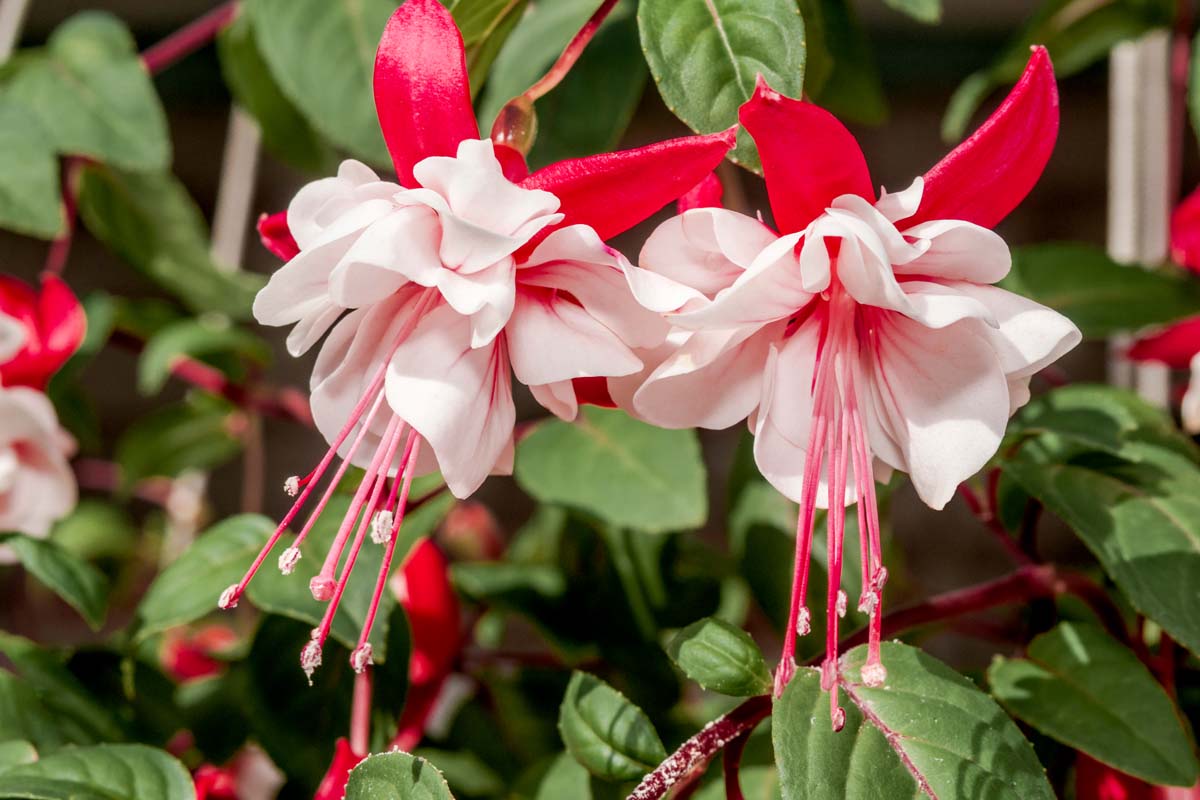
This plant isn’t just a pretty face, though. Those elegant, vibrant flowers are edible as well as decorative. As the blooms fade, small purple fruits form, some of which can be delicious.
Convinced you need to give fuchsia its due and add a plant or two to the garden? Great! Here’s what we’ll cover in this article:
What You’ll Learn
By the time you’re finished reading, you’ll be the resident expert gardener, able to help all your neighbors to coax their own fuchsia to thrive.
What Is Fuchsia?
Fuchsia, pronounced “few-shuh,” is a genus of deciduous, perennial shrubs in the Onagraceae family.
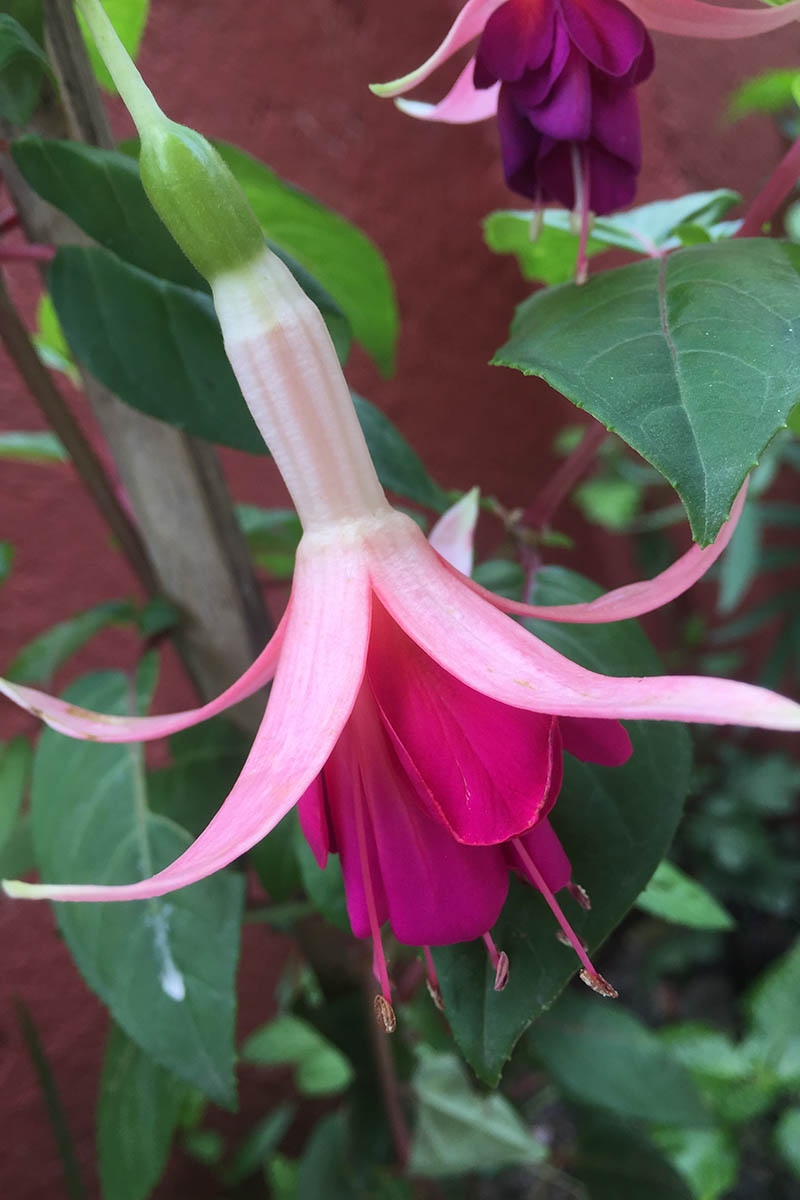
There are over 100 species in the Fuchsia genus, and thousands of named cultivars and hybrids growing in gardens around the world. Most plants available from garden centers and nurseries will be hybrids.
Species may have one of two distinct growth habits: the trailing type that you often see in hanging baskets that are available each spring at your local garden center, and bushier, upright types that grow in the ground and are ideal for planting in containers. The latter may be trained into standards.
The upright varieties can reach mature heights of up to six feet, while dwarf varieties top out at two to three feet.
This eye-catching, vibrant plant is generally grown as a perennial in USDA Hardiness Zones 7 to 10, depending on the variety, while hardy fuchsias, such as many hybrids and cultivars of F. magellanica, can thrive outdoors year-round in a slightly cooler range of growing zones, from 6 to 10.
Many people can’t resist having the plant around, even if they don’t live in the right climate for it to survive the winter. Growing it as an annual is an option, but containers can also be brought indoors to overwinter.

If you go this route, it’s easy to bring your potted plant inside for the winter and put it back out in the garden in the spring. No need to buy a new plant each year!
One look at the flowers and you can probably figure out why it’s sometimes called lady’s eardrops or angel’s earrings.
Throughout the summer, flowers bloom in a riot of shapes and colors, with vivid pink, deep purple, bright red, lavender-blue, peach, and delicate pink and white all making an appearance, depending on the type.
After blooming, 1/2-inch or slightly larger berries form. These turn black or dark blue when ripe.
And they aren’t just for show – these berries, believe it or not, are actually edible. They can taste like grapes, figs, or tart lemon, depending on the variety. Some have an intense peppery afterbite.
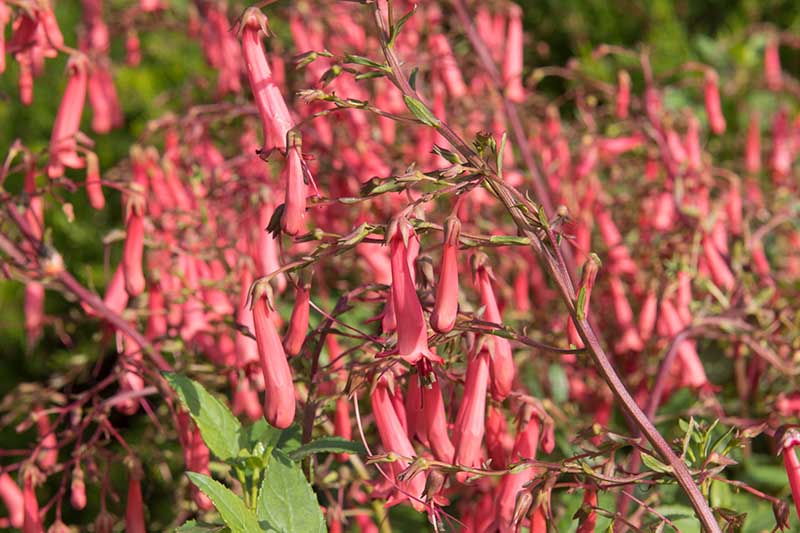
Don’t confuse plants of this genus with cape fuchsias (Phygelius spp.), several species of flowering evergreen shrub native to southern Africa. We’ll cover these in another article.
Cultivation and History
The majority of fuchsia plants are native to South America, with most of the types available for purchase today coming from Chile and Argentina.

There are a few native plants that grow in the wild in parts of South, Central, and North America extending as far north as Mexico.
There are also a few species native to New Zealand, including the world’s largest, F. excorticata, which grows as a tree, and the smallest, F. procumbens.
Charles Plumier, a French botanist, identified the first fuchsia plant while working as a missionary in the Dominican Republic in the late 1600s. He named it F. triphylla coccinea, after Leonard Fuchs, a German botanist born in the late 15th century who is known for his passionate study of plants.
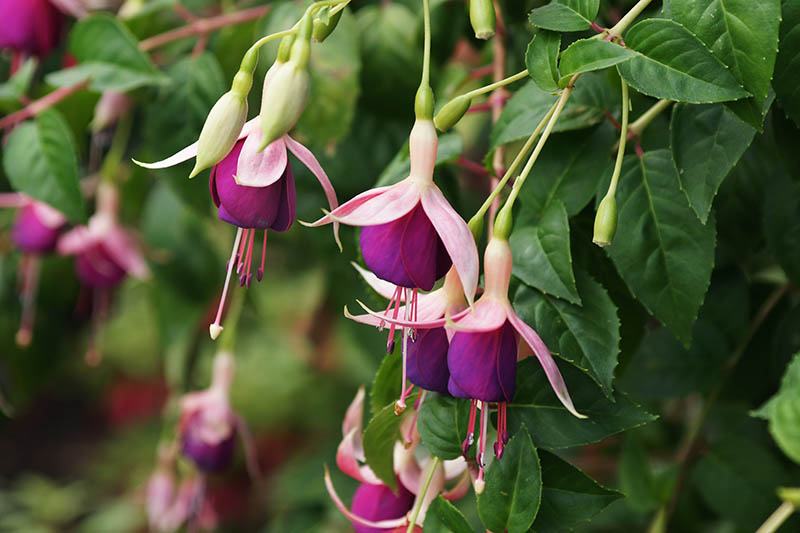
In the 1700s, various species were identified in Brazil, New Zealand, and parts of Central and South America, and by the early 1800s these were making an appearance in European gardens.
Early discoveries, including F. coccinea, F. fulgens, and F. magellanica, gained rapid popularity in England and growers hybridized the plant, creating the first cultivated double flower.
Thanks to the hospitable climate, a number of Fuchsia species naturalized across the United Kingdom and Ireland.
Fuchsia Plant Propagation
Fuchsia doesn’t need too much encouragement to reproduce. Keep in mind that some methods of starting new plants are easier than others.
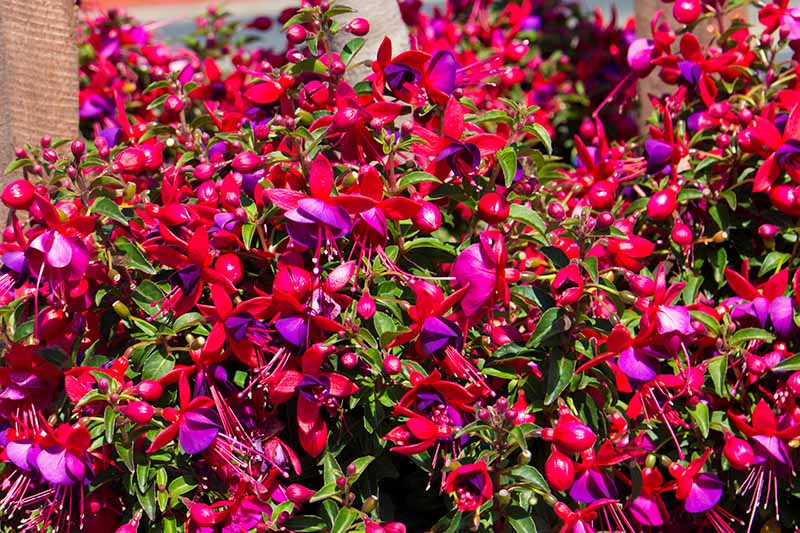
Seeds can take months to germinate.
Softwood cuttings are easy to root, and in some cases you can divide established plants.
Beginning with nursery starts or potted plants from your local garden center is the easiest method.
From Seed
You could purchase seeds, but you can also save some for replanting from a mature existing plant.
If you save seeds from a hybrid plant, keep in mind that they may not be viable, and will likely produce a plant with different characteristics from the parent plant if they do germinate.
Allow a few berries to form and mature until they’re dark in color. Pick them, slice them open, scrape the seeds out, and plant immediately.
If you want to save the seeds, soak them in water for 30 minutes, and then rub the pulp off with a paper towel. Set them somewhere cool with good air circulation to dry.
When they are dry, store them in a cool, dark place in a jar or paper bag.
You can learn more about how to harvest and save fuchsia seeds in our guide.
To sow seeds, use six-cell seed trays filled with a light, porous seed starting mix. Make sure to clean your containers or use new ones, as well as fresh soil, to avoid damping off.
The seeds need light to germinate, so sprinkle them lightly on the soil and press them in place.
Moisten the soil and place the containers in a warm area that’s at least 65°F, near a window where they will get indirect light. Use a heating mat if necessary, as the ideal temperature for germination is 70 to 75°F. Keep the soil moist but not wet.
Then it’s time to start a new gardening project, such as building some raised beds, while you wait one to four months for the seedlings to emerge. When each seedling has two true leaves, thin them out to one plant per cell.
When plants reach six inches tall, and all risk of frost has passed, harden them off over the course of about two weeks.
You can do this by bringing the tray outside to a protected location with indirect light for 30 minutes on the first day, and then bringing it back indoors. Add 30 minutes each day until it can stay outside all day long.
From Cuttings
Propagating from a softwood fuchsia cutting couldn’t be easier. You can take cuttings at any time of year.

Spring cuttings can be planted out as soon as they take root, but late summer or fall cuttings should be overwintered indoors for planting out the following spring.
In the morning, trim off a six-inch piece of stem with three or four pairs of leaves, just below a leaf node, at a 45-degree angle. Remove any leaves from the bottom half.
Prepare a four-inch seedling container with seed starting soil. Dip the cut end in powdered rooting hormone and poke a hole into the potting soil using a pencil. Insert the cutting, planting it so that the first set of leaves is just above the soil line.
Keep the cuttings moist and provide them with a few hours of dappled sunlight each day.
After about three weeks, give the cutting a tug. If you feel resistance, it’s ready to be planted in its container or in the ground.
By Division
Unless you are growing it as a single-stemmed standard, you can divide your fuchsia plant if it has outgrown its space, whether it’s growing in a container or in the ground.
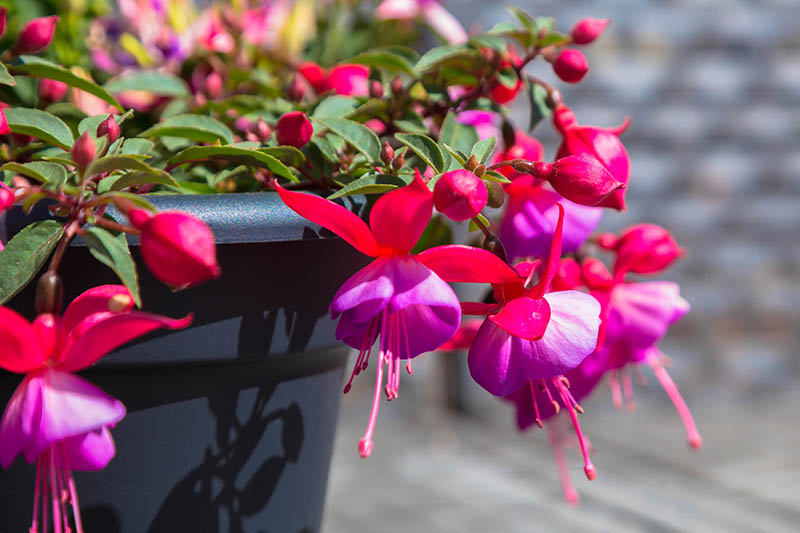
However, if the plant is over four feet tall and well-established, you risk damaging or even killing the parent plant because it is difficult to get enough of the roots out of the ground. Avoid dividing larger plants and try taking cuttings instead.
If you do decide to do this, plants should be divided either in the late fall after they have finished flowering, or early spring when they are still dormant, to limit stress. The plant should be pruned by a third before dividing (more details on pruning below).
Mature plants have an extensive root system, and you need to take care to dig as far out as the foliage was growing on the plant prior to pruning, and as deep as the plant was tall.
Dig up the entire plant, and use a spade to gently leverage the root ball out of the soil.
Gently shake and loosen the soil from around the roots. Use a pair of sharp clippers or a garden knife to cut the plant in half, roots and all.
Replant the original fuchsia, filling the hole back in with soil.
Transplanting
Plants require rich, well-draining soil with a pH between 6.0 and 7.0.
Test your soil and amend it if necessary, particularly if you have heavy clay or sandy soil. You don’t want the plant to be growing in standing water or to dry out too quickly.
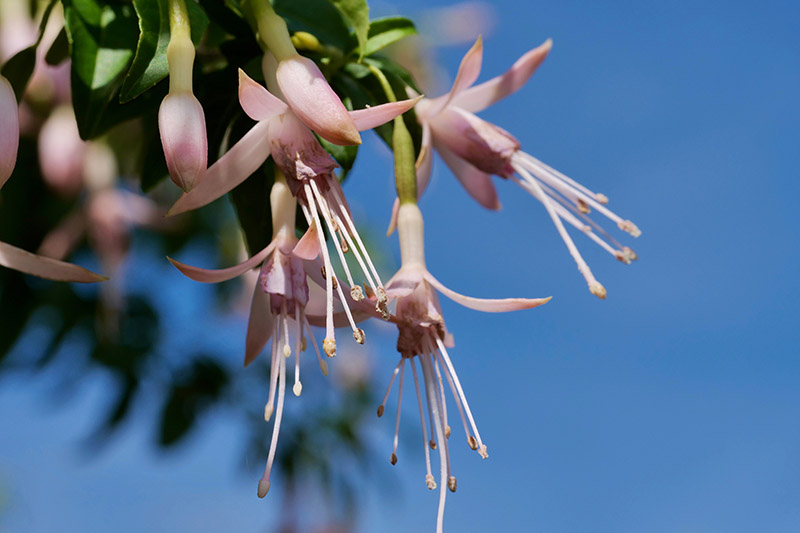
Potted plants need well-draining but water-retaining soil. I like to use a standard potting mix combined with about 10 percent sand and 10 percent perlite.
To transplant, whether you’ve grown seedlings or cuttings yourself or purchased them, gently remove the plant from its pot.
Use a chopstick or your fingers to gently loosen the roots and trim away any that are dead.
Remove the bottom four inches of leaves from the branches of larger plants, and place the plant in the prepared soil. The existing potting soil level of the plant should sit four inches below the soil line.
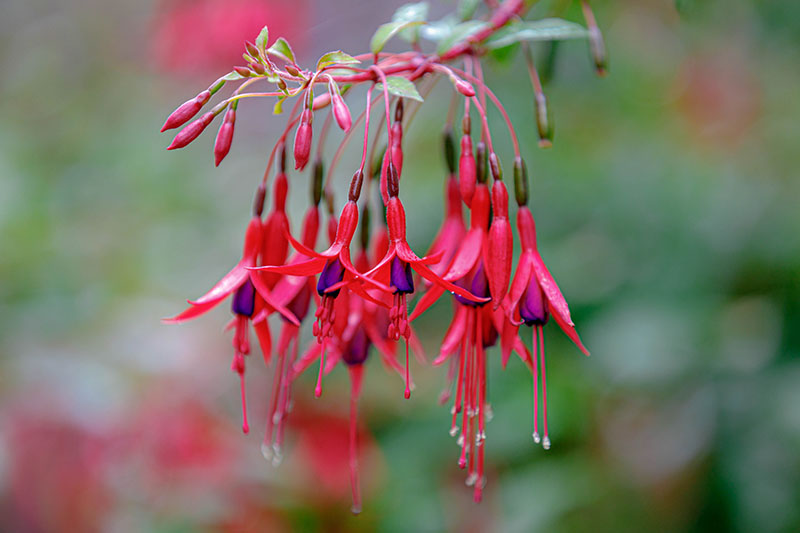
Then fill in with soil so that the ground is even, completely covering the defoliated portions at the base of the stems.
Space upright varieties 12 inches apart or more, and trailing varieties four inches apart.
If you are growing it in a container, your fuchsia may need to be repotted periodically if it has grown too big.
Choose a pot that is one to three inches wider and deeper than the existing container – you don’t want to transplant it to a much larger pot, as these plants can’t tolerate wet feet and excess soil can easily become oversaturated.
Remove the plant carefully from the container, and examine the roots. Remove any dead sections, and at this stage, if you wish, you can divide the plant. Make sure that there is at least one stem on any divided section with attached roots, and replant in fresh potting soil.
Large containers with a big volume of soil tend to retain too much moisture, as described above, and can result in waterlogged conditions.
To keep your plant healthy, it’s recommended that you repot your fuchsia every year or two in fresh soil, even if you don’t wish to plant it in a larger container.
Read more about transplanting fuchsia here.
How to Grow Fuchsia Flowers
One of the common misconceptions about fuchsia is that it doesn’t handle sun well. But that’s not true!
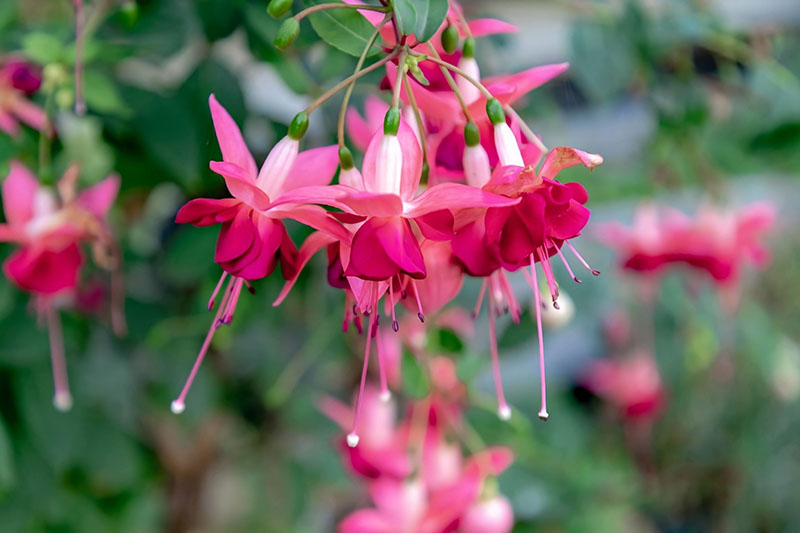
The issue here is keeping the soil moist and cool. While it can happily grow in the shade, it’ll bloom more prolifically if you give it some sun.
The ideal situation is dappled sunlight for eight hours a day, but in cooler areas, you can provide some direct light for several hours. Full early morning sun is fine.
In-ground hardy fuchsia can thrive in full sun conditions in places like the Pacific Northwest, but they should be limited to half a day of sun in hotter areas where full sun paired with high temperatures can cause more of a strain to plants and dry them out more quickly.
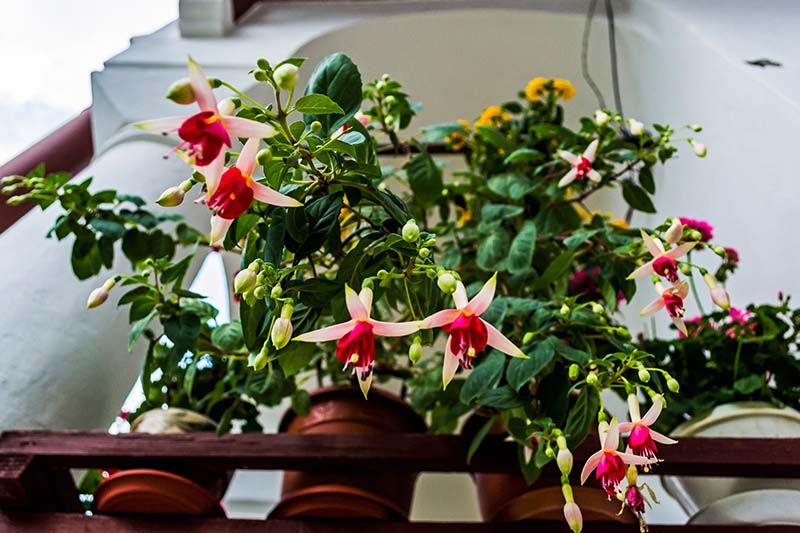
Whether you are growing in the shade or in the sun, the roots can’t tolerate conditions that are too hot or dry. I believe that’s why fuchsia has a reputation of being difficult to grow. Too much heat, and the poor thing just can’t handle it.
Keep the soil consistently moist, but don’t allow the roots to remain in standing water. This plant needs well-draining soil, and doesn’t like wet feet.
The earth should feel like a well-wrung out sponge. One easy way to tell if it’s time to water if you have a hanging plant is to lift it. Feel light? Add water.
Learn more about how to water your fuchsia in this guide.
Don’t let the roots get overheated. Constant moisture will help with this, and a two to three-inch layer of mulch will, too. If you’re growing in a container, keep it in a place where the afternoon sun won’t hit the container directly.
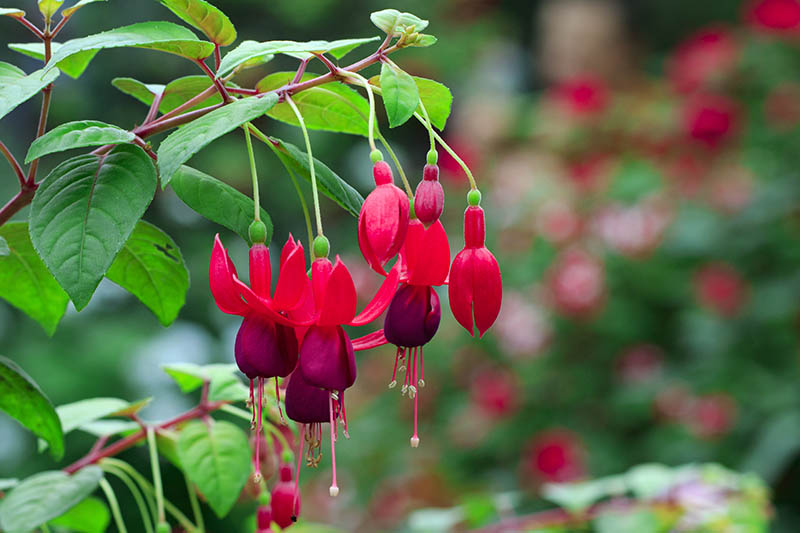
In general, fuchsia prefers temperatures somewhere in the 70s, and about 10 degrees cooler at night, so keep an eye on things when the summer heats up. That’s when many people lose their plants, another reason, I think, that fuchsia has a reputation for being fussy.
To deal with this problem, you can grow it in a container placed in part sun during the spring and fall, and move it into a shadier spot in the summer. You can even bury the container during the hottest part of the year if it really gets toasty in your area.
Keep a close eye on container-grown plants, as pots tend to dry out much quicker than soil in the garden.
On warm days, your plant may start to wilt. This can happen because the plant has closed its stomata to preserve water.
Before you jump in with the watering hose to perk it back up, check the soil. If it feels moist to the touch, don’t add water. If you can move it, take it to a cooler, shaded area and mist it with water to help cool it down.
If the soil is dry, give it a good soak of water. After an hour or so, you can also give it a spritz with a water bottle or use the mist setting on a hose nozzle.
Fertilizing
Choose a fertilizer that is higher in phosphorus to promote root and flower growth. Miracle-Gro Bloom Booster 15-30-15 (NPK), available at Home Depot, is a good option.
Miracle-Gro Bloom Booster Flower Food
Fertilize every two weeks when the plant is in bloom.
If your plant isn’t blooming, feed it with a balanced 18-18-18 fertilizer. Don’t ever apply fertilizer when the soil is dry or if the plant is wilted.
Hardy fuchsias growing in the ground can be fertilized every two to four weeks with 18-18-18 (NPK) during the growing season.
Slow fertilizing to once a month starting in October, and stop entirely when plants are dormant over the winter months. You can start fertilizing again when your plant shows signs of new growth in the spring.
Growing Indoors
Some people toss fuchsia at the end of the summer, after it has finished blooming.
You can also take your plants indoors to overwinter them in pots and they’ll return in the spring better than ever.
Read more about growing fuchsia as a houseplant.
Growing Tips
Fuchsia has some specific needs, but once you know what they are, you can keep this plant happy without too much effort.
- Keep the soil moist but not wet. The top half inch shouldn’t be allowed to dry out completely between watering.
- Plants can handle full sun so long as they don’t get too hot. Put them in part sun or part to full shade if temps climb above 70°F.
- This plant has high nutritional requirements. Feed it regularly.
Pruning and Maintenance
You need to deadhead these plants to encourage continual blooming. Otherwise, the pollinated flowers turn into fruits.
You can eat the fruit, but allowing them to develop will also mean the end of blossom time.

If you keep up with deadheading, your plant can continue to bloom even through the winter if you live in an area that stays warm enough, with daytime temps between 60-70°F, or if you keep the plant indoors.
You might need to move it into full sunlight to encourage flowering, however, if it isn’t growing in a full sun location already.
Most species start blooming in June, and fuchsias develop blossoms on new growth.
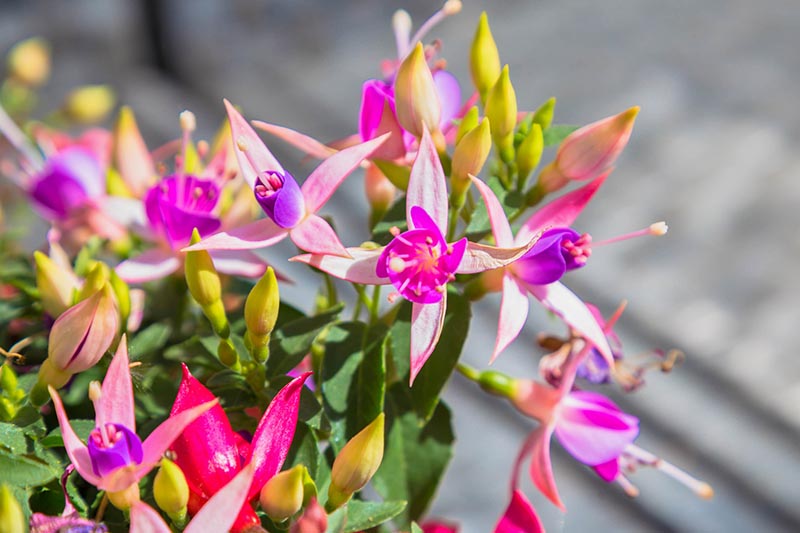
What does this mean for you? Plan to prune the plant back to keep its shape in the early spring when new growth just starts to emerge, but before flower buds have formed. Resist the temptation to prune in the fall, as this can leave plants vulnerable to frost damage.
Remove any dead or crossing branches and any branches that look weak or spindly. You can also prune the entire plant back by a third, if desired.
Prune the branches of potted plants back by one-third, but be sure to leave at least two leaf nodes in place on each.
Read our full guide to fuchsia pruning for more info.
Pruning time is ideal for repotting, as well. If your plant has become root bound, pull it from its current container, gently loosen the roots, and remove any that are dead before replanting.
Smaller plants grown in the ground or in containers can be divided, if desired, every few years as described above, though this is not necessary.
Again, remember that it is important to take care to dig up as much of the root system as possible for any plant growing in the ground. These beauties have deep root systems, and larger plants do not respond well to transplanting.
Mulch with two inches of well-rotted compost, straw, or grass clippings to keep the moisture in place in the soil, keep the roots cool, and protect the plant from winter chills.
Species and Cultivars to Select
Be aware that if you want to enjoy the fuchsia berries, single-flowered cultivars usually produce better fruit.
With thousands of hybrids and cultivars to choose from, you’ll need to decide whether you want a trailing type to spill out of pots on your patio, or a hardy upright variety to plant in the garden.
And then you’ll need to choose from the dazzling array of colors!
Hardy
Hardy fuchsia (F. magellanica) is a favorite among many home gardeners because it lives up to its name. It can handle a freeze and a little bit of dry soil won’t send it into a death spiral.
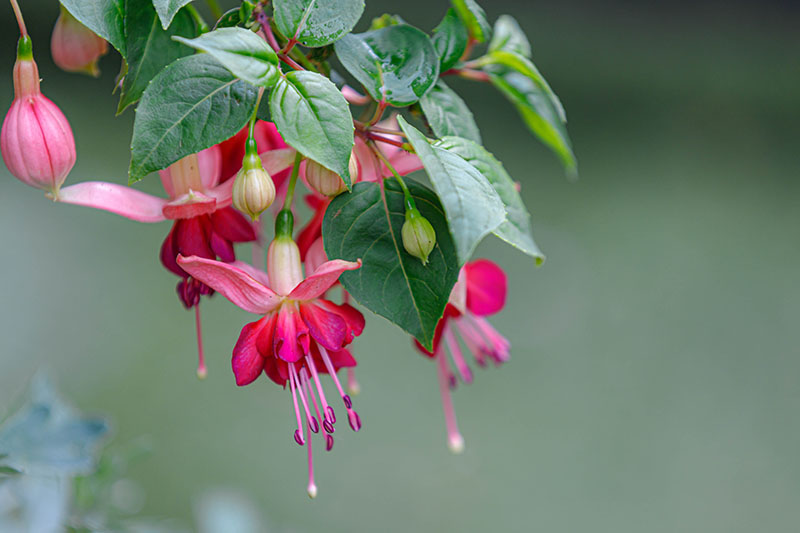
That’s not the only reason to love it, however. Of all the fuchsia species, it has some of the best-tasting berries, with a ripe grape flavor followed by a peppery afterbite.
Also known as hummingbird fuchsia, the hardy species can be overwintered outdoors in locations as far north as USDA Hardiness Zone 6.
I’ve heard of people keeping it outdoors in even colder climates, though you’ll need to be extremely liberal with the mulch.
F. magellanica ‘Dollar Princess’ is another hardy option, a bushy shrub with incredible pink and purple double flowers with full, ruffled blossoms.

This cultivar is an ideal option if you want something that will act as a centerpiece in your patio garden, since it does well in containers.
Peruvian
Peruvian fuchsia (F. corymbiflora) is a beautiful plant with bright pink or red and white flowers. The blossoms are long and narrow.
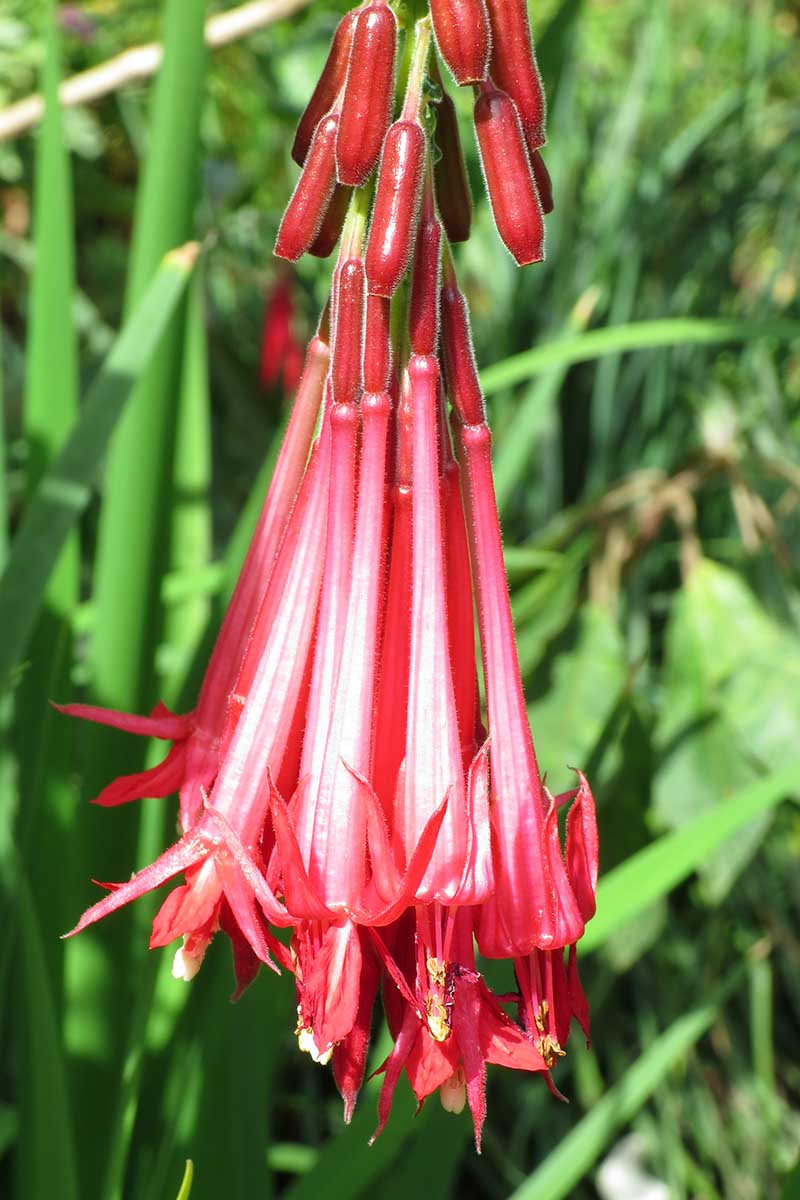
While it’s perfectly lovely as a garden specimen, I recommend it because it has delicious fruit as well, with a sweet fig-like flavor. It doesn’t have the peppery afterbite that the fruit of many other species have.
Thyme-Leaved
Thyme-leaved fuchsia (F. thymifolia) is a variety from Mexico. It has tiny leaves and miniature dark pink flowers, which makes it ideal if you want a plant for bonsai, or one that will grow well as an accent in a container garden.
It blooms from April to November in temperate regions, but note that it can’t handle even a light frost.
Creeping
Want all the fuchsia goodness, but you wish you could grow it as a ground cover? Meet creeping fuchsia, F. procumbens, a New Zealand native.

Not only does it spill over the sides of containers, trail down walls, or creep along the ground, it has orange-yellow blossoms in summer and red berries in the fall. It can even handle a bit of drought.
Looking for the Perfect Fuchsia Plant?
You can learn more about the different varieties of fuchsia in our “17 of the Best Fuchsia Varieties to Grow in Your Garden.”
Managing Pests and Disease
Here’s the good news: deer and rabbits avoid fuchsia. You don’t have to worry about these fuzzy critters nibbling on your plants.
The bad news is, bugs aren’t afraid to take a bite. There are a few diseases to look out for, too.
Insects
Insect infestations can damage your plants and leave them vulnerable to bacterial or fungal infection.
Aphids
Aphids are particularly bothersome for plants growing indoors, but they can also attack outdoor plants. There are multiple types of aphids that will feed on these plants, most notably the potato aphid (Macrosiphum euphorbiae).
These bugs use their sucking mouthparts to draw out the juices from plants. They leave behind honeydew, which attracts ants and encourages sooty mold. Plants can become wilted and yellow.
To start, spray your plants with a blast of water to knock the aphids loose. If that doesn’t do the job, sprinkle your plants with flour to constipate them.
You can also spray with a product containing neem oil or insecticidal soap if the first two options don’t work to solve the problem.
Fuchsia Gall Mites
Fuchsia gall mites (Aculops fuchsiae) are nearly invisible to the naked eye, but the damage they leave behind isn’t. They cause flowers and shoots to become disfigured and swollen.
To control the problem, prune away infected branches to an inch below the damage.
You’ll have to keep at it, but eventually you should be able to prune out all of the plant material that has been affected by the mites.
Also, be sure to wash and sanitize your tools every single time you work on the plant, because mites are easily transmitted by gardening gloves, pruners, and other gardening implements.
Apply an insecticidal soap following the manufacturer’s recommendations. This won’t kill all the mites, but along with pruning, it can help you to get things under control.
Whiteflies
Whiteflies are common, and a pain to get rid of. There are dozens of species that attack plants, both indoors and out. However, if you are diligent, it’s possible to be victorious against this foe.
Mix a cup of 70 percent isopropyl alcohol with a few drops of dishwashing liquid and three cups of water. Mix well and spray plants daily until the infestation is gone.
The spray must come in contact with the bugs to kill them, so keep an eye out and spray all parts of the plant.
Learn more about controlling whitefly infestations here.
Disease
If you keep aphids away and are cautious about watering, you can generally avoid the diseases that most commonly attack this plant. Still, there are a few things you should watch out for.
Botrytis Blight
This disease is caused by the fungus Botrytis cinerea. It likes low temps and high moisture – just like fuchsia does.
If your plant contracts this disease in the spring, it can cause the flower buds to be aborted. It can also cause yellowing of the leaves and may cause leaves to drop off. You’ll often see brown, decayed areas on the leaves and stems.
Remove any infected parts of the plant. In humid conditions in particular, make sure you’re only watering at the base, not on the leaves. Water in the morning so plants have time to dry during the day.
Damping Off
Damping off is caused by a variety of species of fungi (Fusarium spp., Rhizoctonia spp., and Pythium spp.), which can cause seeds to fail to germinate or seedlings to wilt, become water-soaked, and even die off entirely. If an affected seedling does survive, the plant will likely never be healthy and robust.
The first step is to try your best to avoid it. You can do this by cleaning your tools and pots before planting and use only fresh potting soil.
Keep whiteflies and aphids away, and keep seedlings at around 70°F. Don’t fertilize seedlings.
Finally, if you do notice signs of this disease, dispose of the seedlings and the soil, and sterilize your tools and containers before using them again.
Read more about preventing damping off here.
Rust
Fuchsia rust is caused by the fungus Pucciniastrum epilobii. At first, you’ll notice leaves starting to turn yellow or brown, and rusty pustules will appear on the undersides. The leaves will begin to shrivel up and fall off the plant. Rust may also cause a leaf bud drop if the plant is waking out of winter dormancy.
If you notice this happening, prune away any infected leaves. Thin plants out so they get better air circulation and only water at the base of plants.
Best Uses for Fuchsia Flowers
These plants have a variety of uses in the garden.
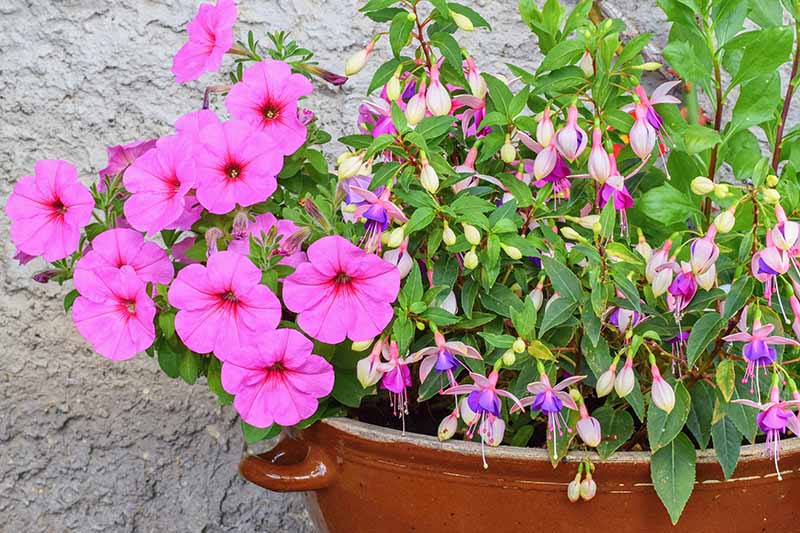
You can train them as standards with a treelike form, grow them in pots or hanging baskets, or plant them in the flowerbeds and allow them to develop into their natural habit as attractive specimens in the garden.

Upright types can even be trained as bonsai.
Quick Reference Growing Guide
| Plant Type: | Flowering woody perennial | Flower / Foliage Color: | Orange, pink, purple, red, white; green |
| Native to: | Central America, New Zealand, South America | Maintenance: | Moderate |
| Hardiness (USDA Zone): | 6-10 | Soil Type: | Loamy, water-retaining |
| Bloom Time / Season: | Spring-fall | Soil pH: | 6.0-7.0 |
| Exposure: | Full shade-full sun | Soil Drainage: | Well-draining |
| Spacing: | 12 inches, depending on variety | Attracts: | Hummingbirds |
| Planting Depth: | 4 inches deeper than existing container | Companion Planting: | Cosmos, hostas, hellebores, rhododendrons |
| Height: | 18 inches-6 feet | Uses: | Container, specimen, hanging plant, edible berries and flowers |
| Spread: | Up to 5 feet | Order: | Myrtales |
| Time to Maturity: | 18 months from seed | Family: | Onagraceae |
| Water Needs: | High | Genus: | Fuchsia |
| Tolerance: | Shade, moisture | Species: | coccinea, fulgens, magellanica, procumbens, thymifolia |
| Common Pests: | Aphids, fuchsia gall mites, whiteflies | Common Diseases: | Botrytis blight, damping off, rust |
Get Ready for Long-Lasting Color, Even in the Shade
If you’ve only seen the purple and pink type of fuchsia hanging out in the home and garden store, give this stunner another look. With a variety of colors, shapes, and sizes available, this plant may just surprise you.
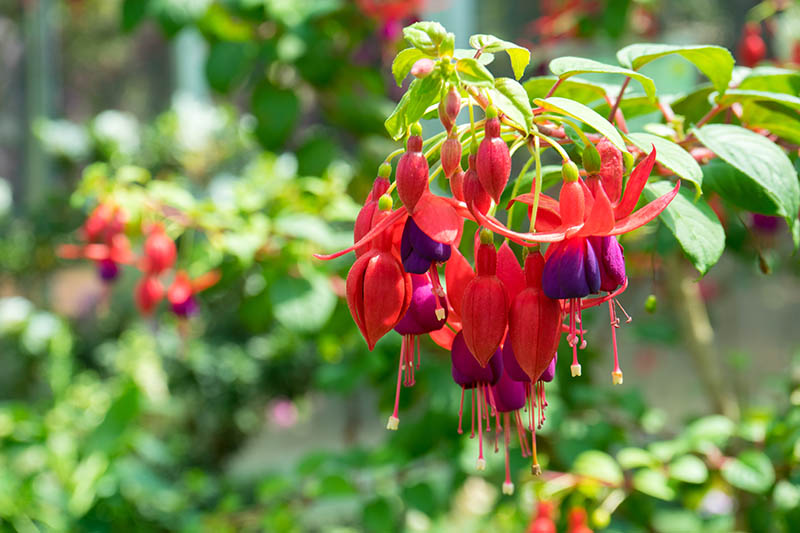
It is invaluable as a provider of color in the shade, but its features don’t stop there. You can find cultivars of this long-blooming ornamental that don’t mind some heat or even full sun. Some can withstand a bit of a freeze, and others will crawl along the ground and spill over the edges of pots.
Now that you’re prepped and ready to go, I’d love to hear how you decide to grow your own fuchsia. Let me know in the comments below. And feel free to share a picture!
Looking for a few more plants that can provide some much-needed color in the shade? Check these guides out next:
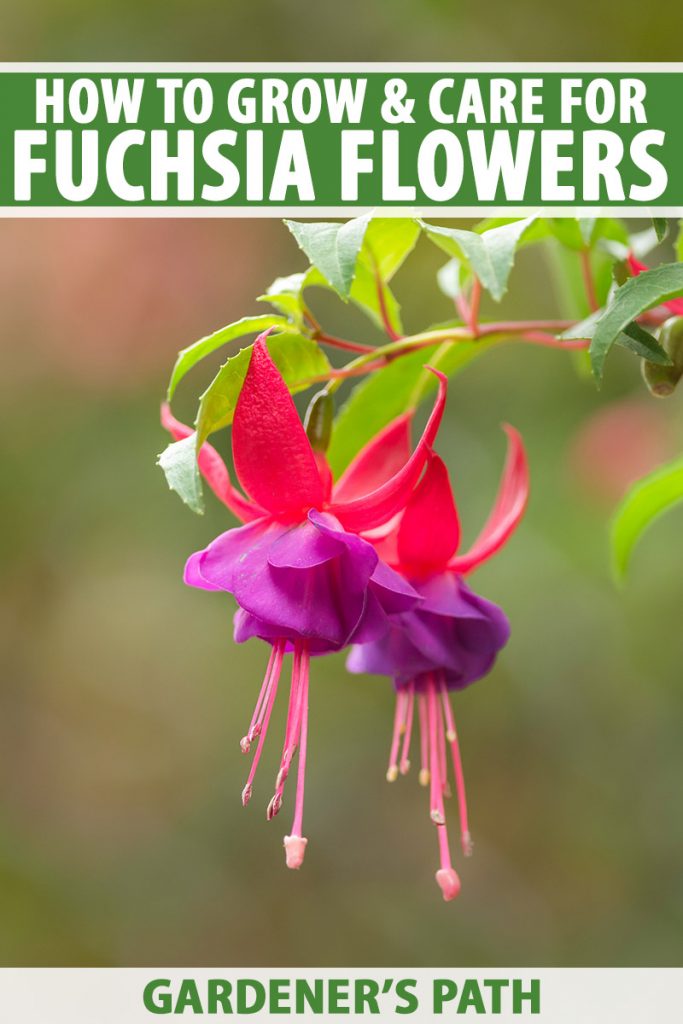
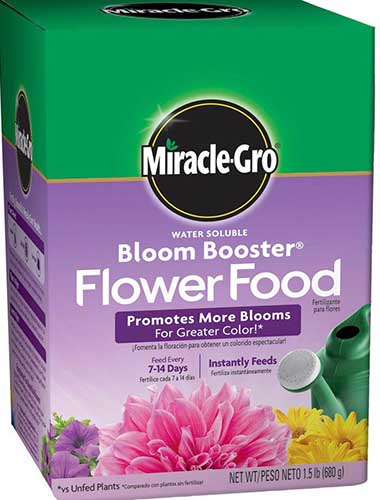

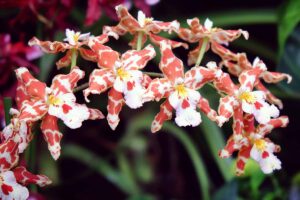
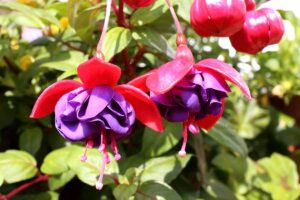
Your artical is amazing! I learned so much reading it.I don’t think there was anything you didn’t cover.Thanks????
If the plant dies and the stems are dead, but the roots still seem alive, can you repot the roots and hope new life comes back?
Hi Linda, the good news is that you can absolutely regrow a fuchsia that dies back to the ground, so long as the roots are alive. You don’t even need to repot it unless you suspect that the soil is compacted, depleted, or infested with disease. Of course, it won’t hurt to repot it. I’ve “killed” many a fuchsia over the years by leaving them out in weather that is too hot or too cold, and they almost always come back. First, cut all the dead growth back to the soil level. Next, support it with water (not too much)… Read more »
My fuchsia has large buds that have not bloomed since I got it around 5 weeks ago. I have been feeding it Fox Farm liquid plant food as directed, it gets some morning sun and noon time sun.
I have heard I can cut open the blooms, but I don’t want to hurt it.
The fox farm plant food is called “big bloom” 🙂
Hi Erin, what a gorgeous plant! I wouldn’t cut open the buds. If they aren’t opening, there’s a reason, and forcing them doesn’t address the problem. First, it sounds like the plant is receiving enough sun, but it doesn’t hurt to give them a bit more if you can. Just avoid the heat of the afternoon. I know that most blooming problems I have are related to too much shade. Next is too little water. Fuchsia can be a bit temperamental about being moved, so if the buds were developing right when you brought the plant home and then its… Read more »
My fuchsia has lots of buds, but drops many of them. I keep it outside in the morning sun, and move it to the shade in the afternoon. I live in southern California. Even when a bud opens, many of the flowers don’t look right. Too much or too little water?
Hi Debbie, when you say that they don’t look right, could you describe what they look like? Or draw a picture? There are many things that can cause the flowers to drop. We actually have a guide dedicated to dropping fuchsia buds that might help you narrow down the cause. If you feel the soil with your finger, how does it feel? Soggy? If you were to ball a little bit up, does it stick together? That means you’re overwatering. If you touch the soil and it feels dry, especially if your plant is wilting, it’s not receiving enough water.… Read more »
Anybody donate Fuchsia viable seeds for our public garden in Mysore India